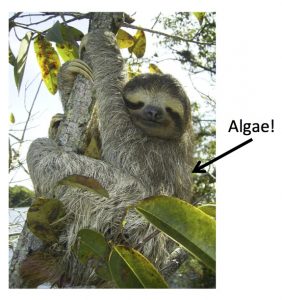Algae + sloths + moths = an interesting three-way mutualism
As part of a very interdisciplinary collaboration with some awesome wildlife ecologists at the University of Wisconsin, a new paper co-authored by Cayelan has recently been published as the cover article of the latest issue of the Proceedings of the Royal Society B, see the link here.
Sloths spend the majority of their time resting in the canopy of tropical forests. However, every week a sloth will embark on a risky endeavor and descend a tree to defecate. In this paper, we explored exactly why sloths carry out this risky behavior. Our data suggest that it may be due to a three-way mutualism between sloths, algae, and moths that live on the sloth. By descending to the forest floor, sloths promote moth colonization of their fur. Moths, in turn, act as fertilizer and increase the amount of nitrogen in sloth fur, which fuels algal growth. Sloths consume the highly digestible and lipid-rich algae to augment their limited diet. This complex syndrome of mutualisms between moths, sloths and algae reinforces fundamental aspects of the sloth’s behavior and life history, and may also reinforce the slothfulness of sloths.
This work is generating a bit of buzz in the ecology world, with coverage by the New York Times, Time, the Smithsonian, National Geographic, and others. While this is the Carey Lab’s first foray into sloth science, we are excited to further understand the ecology of the algae living on these very cool creatures.
A very cute three-toed sloth, image modified from http://en.wikipedia.org/wiki/File:Bradypus.jpg
